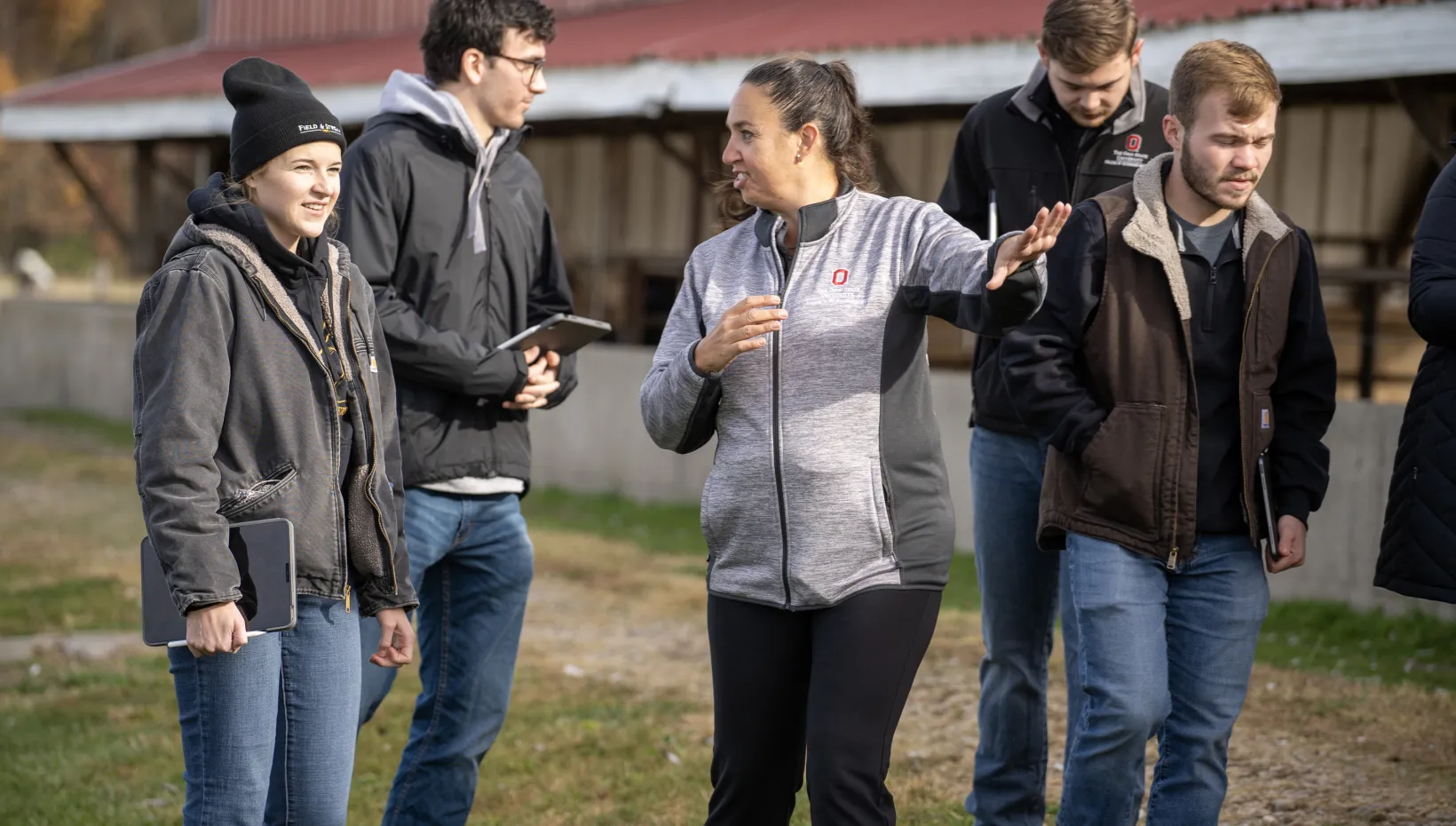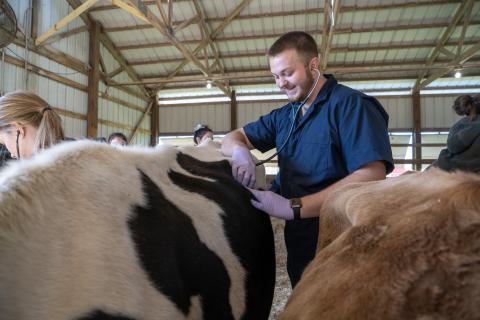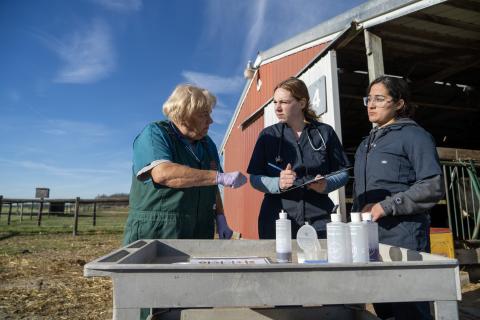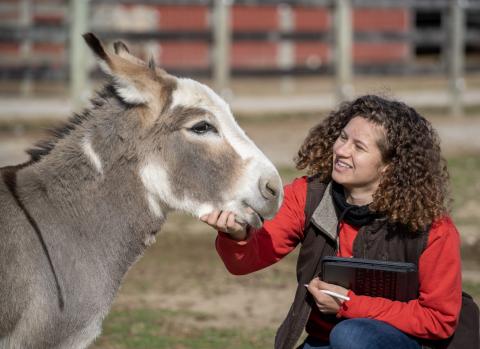Hands-on experience outside the classroom from day one

Article by: Allison Burk
Originally Published
The Ohio State University College of Veterinary Medicine is revolutionizing how veterinary students are taught with the recent launch of its new curriculum.
A significant component of the new curriculum is providing opportunities for students beginning the first week of their first year to have regular and recurring hands-on experiences outside the classroom, giving them a broader understanding of their future careers and preparing them to be confident and competent, practice-ready veterinarians.
Because many students may not have prior exposure to livestock or exotic animals, despite needing to learn about them as future doctors, it is important to provide such experiences. While students in previous years had some opportunities to visit facilities, it was less frequent or not until their fourth-year clinical rotations, which was often too late for people to discover they might have an interest in such a career path.
New courses designed to apply lecture-setting learning
Students can apply what they are studying in a lecture setting through hands-on experiential learning in a variety of settings outside of the classroom. Healthy Populations is one of the core courses within the new curriculum that runs the entire first year. It provides many opportunities for hands-on experience for students starting on the first week of the first year of their DVM education and building throughout their four-year program.

The course is divided into four blocks, designed to introduce veterinary students to the science and medicine of groups of animals and various species. In the first three blocks, students evaluate the health of animal populations, describe how pathogens are transmitted between animals and humans, and identify strategies for addressing threats to animal, human, and environmental welfare and safety.
In the final block, students compare and contrast various types of information sources used in veterinary medicine, analyze primary literature in veterinary science, and apply evidence-based literature to animal, human, and environmental health veterinary issues.
The course is structured to teach students about veterinary knowledge focused on the interface of people, animals, and the environment, incorporating One Health and One Welfare concepts. It aims to help veterinary students understand diseases and issues using the simple logic of ‘you can’t know what abnormal is until you know what is normal.'
Jacqueline Nolting, MS, PhD, assistant professor of veterinary preventive medicine at Ohio State, co-leads the Disease Prevention and Control block in the course, which challenges students to think critically about population health. Nolting takes her students outside the classroom to various animal settings, such as farms and shelters, where they are divided into groups and must work together to create a template for assessing the health of populations.
Unique settings offer real-world experiences
When students are at these off-site locations, they have the opportunity to use the population health assessment templates they created to learn about things such as biosecurity measures, proper ventilation, and stocking density to assess the overall health of animal populations. Nolting emphasizes that many students have never visited farms such as this, so the course provides them with new experiences to broaden their horizons.
“This course is designed to go beyond traditional lecture settings and provide students with real-world experiences, allowing them to apply what they learn in the classroom,” said Nolting. “We assess students using application-based assessments completed during class time and weekly quizzes rather than exams.”

Emma Read, DVM, MVSc, DACVS, associate dean for professional programs at Ohio State’s College of Veterinary Medicine, echoes the importance of experiential learning for veterinary students.
“Gen Z learners, who comprise most of our student population, are digital natives and prefer independent, highly visual, and kinesthetic learning. In addition, the students value mentoring, and relationships with experts in the field,” said Read. “Healthy Populations provides the opportunity for students to interact with faculty and industry experts in ways that were not possible in the past,” Read said.
Holistic curriculum elevates preparing future veterinarians
Mark Flint, BVSc, BSc(Hons), MApplSc, MPhil, PhD, DACAW, associate professor of veterinary preventive medicine and Program Head of Zoo & Wildlife Conservation Medicine, Ecosystem Health & One Welfare at Ohio State, describes the Healthy Populations course as providing a holistic set of tools to assess and communicate welfare and well-being of animal populations for students throughout their veterinary training and professional career.
Flint’s section of the Healthy Populations course covers Animal Welfare, Ecosystem Health, One Health, and One Welfare. Students visit The Wilds, a private, non-profit safari park and conservation center that is overseen by the Columbus Zoo and Aquarium that combines conservation science and education programs, and is home to several rare and endangered species of animals.
“The Healthy Populations course teaches the concept of One Welfare from day one, providing students with a deep understanding of how environment, society, and culture can influence animal health and welfare and why that is so important to us as veterinarians,” said Flint.
Flint sees benefits for both faculty and students with the new curriculum. For students, he says this includes a more logical flow to learning, building on foundational knowledge to increase understanding, a less competitive but meaningful assessment regime, and a more dynamic way to learn.

He also acknowledges a wonderful camaraderie and collegiality among the students, noting that the first-year students have risen to the challenge of this new course and that the second, third, and fourth-year students have all been supporting them by listening to their concerns, advocating for them when needed and sharing their own experiences.
For faculty, Flint says the new curriculum has allowed them to reimagine their teaching plans and methods while having direct buy-in to develop the content they feel is most relevant and up-to-date for their students. He adds that it has allowed faculty to explore their professional passions and interests and fold them into the new curriculum.
The hands-on experiences provided in the Healthy Populations course allow students to apply their classroom knowledge to real-life situations, making them more equipped to handle the challenges of their future careers. The inclusion of the new course reflects the college’s commitment to advancing education and student success and moving us closer to our ambition to Be The Model® comprehensive college of veterinary medicine in the world.